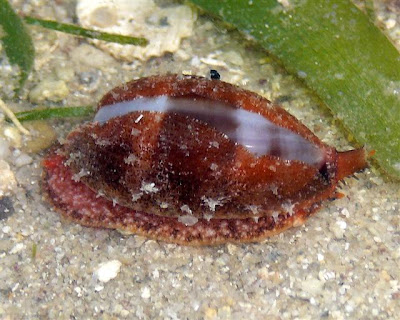
Cyrene Reef is a beautiful reef that only emerges at low spring tides. Visiting Cyrene when dawn breaks reveals a stunning landscape of the glowing sunrise, giving me a glimpse of heaven on earth.

Cyrene Reef is the only place in Singapore you can find over 100 knobbly sea stars in one location. There are many juvenile ones around and the Star Tracker study has shown that 45% of them are juveniles according to their past surveys. They are absolutely cute!

Juanhui says she wants to see the blondie star again. Soon, I chanced upon this star that looks quite blondie but not exactly like the one we saw. The Star trackers (Chee Kong and Sijie) and I think that it should be still a knobbly sea star (Protoreaster nodosus).

Andy found this common sea star with three arms. Interestingly, you can see the two arms starting to regenerate.

Chee Kong found this attractive purple six-armed scaly sea star (Nepanthia sp., probably Nepanthia belcheri)!

One distinctive feature of this sea star is that its upper or aboral surface has distinctive cresentic shape of the aboral plates which, with their convex edges appearing to overlap distally, somewhat resembling fish scales.

The grooves where the tube feet are is in orange colour as compared to the purplish body.

Somehow, God blessed my Cyrene trip today because I get to see what the team saw yesterday. One of which is this stunning juvenile orange cake sea star (Anthenea aspera) which Juanhui saw the day before.

Juanhui also found the juvenile cushion sea star (Culcita novaeguineae), that July found yesterday! Great as I wanted to see this. The black upper surface with yellow spots is so pretty!

The underside of the cushion star reveals reddish oral surface. In fact, it is about 9cm in diameter so it's more of a young adult rather than a juvenile in my opinion. Haha.

Andy found the huge nudibranch that was found yesterday as well. This is possibly Dendrodoris tuberculosa.

As for me, I found quite a number of this small sea hare that will release purplish inks when disturbed.

There were also a number of flatworms on the seagrass lagoon.

This black flatworm with brown fringe is not as commonly seen as the orange spotted one above.

This bristleworm was found near a hole on the ground.

Though wormy-looking, this is actually a synaptic sea cucumber. Usually we find them in brown or black colour.

However, it's rare to find one that is white with some dark stripes.

A closeup of this synatpic sea cucumber reveals its tentacles.

Chee Kong, Sijie and I went straight to the other extreme of Cyrene Reef for our first time (Yes, Cyrene is huge!). This part is where you can find the orange beacon that Melvin always joke about that if we are late for departure, we have to climb this beacon to avoid being submerged with the reef.
Anyway, we wanted to find the larger adult knobbly sea stars but to no avail. Juanhui found them later though.

There are many barnacles growing, even on the wall of the beacon.

This area of Cyrene has quite good coral growth.

I came across this pair of red egg crab which made me puzzled what exactly they are doing.

Of course there's the ever clever and colour changing octopus that never fail to impress me.

Chay Hoon spotted a bad, wrong, bat fish, that swims sidewards left and right instead of a direct displacement.

She also shared with us a new find! A cowrie that has red mantle. We have not seen one with red mantle before. Ria says it might not even be a cowrie at all, could be a false cowrie. But we are all excited to want to know if this is a new species record for Singapore.

Soon, it was time to leave Cyrene before it gets submerged under the rising tide. It's amazing how the fantastic reef can coexist in the middle of the shipping lanes surrounded by petrochemical islands. Yet the pollutions and work done around it continues to be a threat as there is always a limit to resilience you see.
Let's hope Cyrene Reef will remain for our next generations to see. It is a natural heritage that we own for ourselves and be proud of it.
Wow, those are really nice starfish. :)
ReplyDeleteMiracles of Nature
I am impressed with your photos of all these beautiful starfishes.
ReplyDelete